InSoFast makes running electrical wires in a solid concrete wall easy with our pre-installed wiring chases. Electrical wiring chases are one of the many features built into the InSoFast panel. They run vertically at 16″ on center and horizontally at 24″ on center in the panels. This grid-work provides easy access to pull the wiring to any location. The chases also address the necessary separation from the drywall that’s required by electrical code.
Making Cut-outs for New Outlet Boxes
Professional Tool for Cut-outs
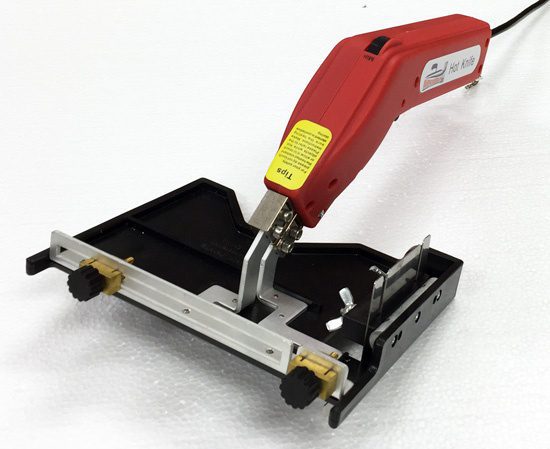
Hot knives are clean and professional cutting tools and one of the many options for cutting out for electrical boxes, but a razor knife will work just as well if you are not a professional installer.
Start by pressing the outlet box against the foam of the panel to create a mark. Cut out the foam approximately 1/4″ – 1/2″ larger on all sides than the impression. While a tight-fitting electrical box would look nice, it is better to have extra room to seal around the outlet box with expanding foam.
Cut out the foam with a snap-off blade knife. Continue to cut out to the nearest horizontal or vertical chase. The vertical chases are centered directly between the InSoFast studs and are indicated by a line on the front side of the panel. The horizontal chases are located at the top of each panel.
Electrical wiring chases are one of the many features built into the InSoFast panel. They run vertically at 16″ on center and horizontally at 24″ on center in the panels. This grid-work provides easy access to pull the wiring to any location. The chases also address the necessary separation from the drywall that’s required by electrical code.

Running or Pulling wires

Romex® type wiring is simple to install. Individual runs can be pushed or slid through the horizontal or vertical chase ways up to 12′ from box to box or up into the floor system.
If you have any difficulties sliding the wire through the chase way, bend over the end of the Romex® wiring. The use of a fish tape is generally not required unless pulling multiple wires at one time. If you wish to eliminate the fish tape, slide one wire through and then tape the multiple wires on. Metal flex conduit, MC Flex, or AC Flex installs in the same manner as Romex wiring.
It is okay to over cut the InSoFast Panel.
To make things easier and give you extra room to work with the wiring, cut the opening up to the horizontal chase way. Once the electrical work is completed the foam can be pieced back into place and air sealed with spray foam. Alternately if homeruns or larger openings are needed the foam can be cut back to the studs and completely removed.
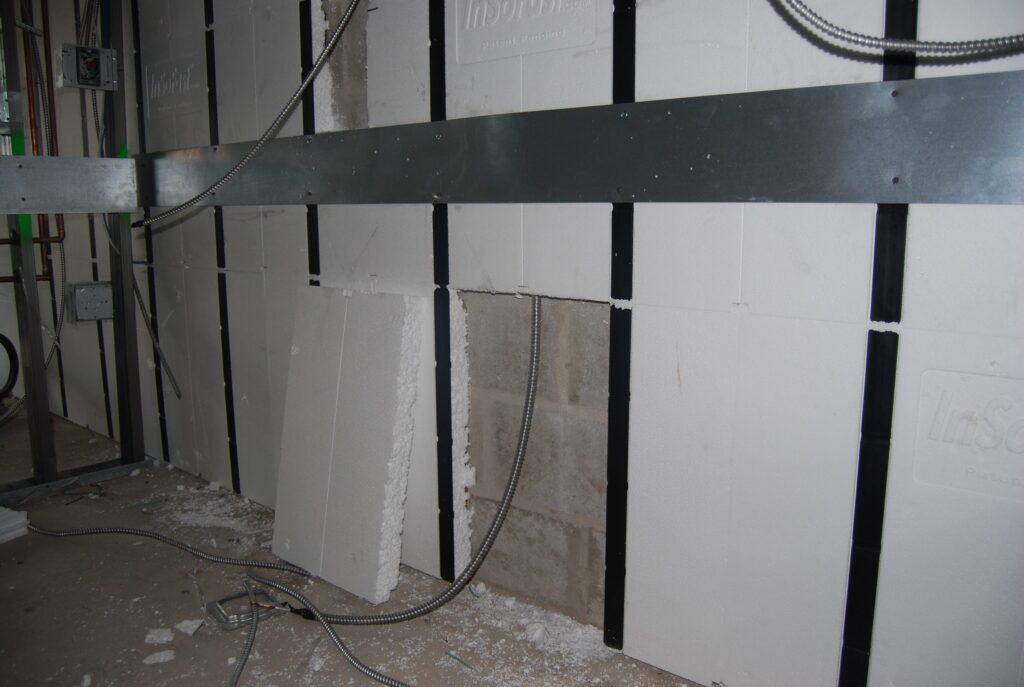
Save the cut foam to use later after the electrical work is completed.

How do I change wiring direction turn a corner?
Pulling wires around corners or changing directions from wall to ceiling with InSoFast is simple. Once the wall/surfaces is up and the adhesive is set you can cut out and replace the insulation easily. This corner technique will also work at junctions at frame walls. You can even update an pull wires through InSoFast after the wallboard or gypsum panels are on the wall.

Installing Outlet Boxes
Types of Wiring
InSoFast panels are designed for use with standard Romex® (NM sheathed wire), MC Flex, AC Flex, or rigid metal conduit.
InSoFast wiring chases are located 1¼” below the surface of the panel (National Electric Code – NEC Article 330-4d and 300-41a) and are designed to keep the wiring safely within the panel without the use of protective metal plates. The chases are spaced 16″ o.c. vertically and 24″ o.c. horizontally. This offers the same protection as a wire running through the center of a 2×4 wall.
Secure electrical boxes directly to the concrete wall with adhesive or a mechanical fastener, anchors or screws (for masonry walls). Once securely fastened to the wall, fill the extra space around the box with expanding foam. The foam air and water seals the electrical. All of our recommendations are based on National Codes requirements. Please check with your local building departments for local amendments.
Types of Electrical Boxes

You can use any code approved plastic, metal, or fiberglass electrical boxes.
Suppliers for shallow nonmetallic electrical boxes and enclosures in to fit our 2″ thick panel for residential, commercial and industrial markets.
Brand: fiberglass BOX Single gang electrical box for use with nonmetallic sheathed cable.
- Product Description
Single gang electrical box for use with nonmetallic sheathed cable
Brand: fiberglassBOX™
Catalog #: 9331-EK
Height: 3-1/4 in.
Width: 2-3/8 in.
Depth: 2-1/2 in.
Volume: 14 cu. in.
Type of Installation: Old WorkAllied product link for the 2 ½” deep electrical boxes.
Allied product link for the 3” deep electrical boxes.
For other available sources for shallow nonmetallic electrical boxes.
When working with existing electrical wiring various extension rings can be used to add additional wiring capacity to the electrical box. This extension ring features a keyhole design, this extension can be used to add additional wiring capacity to almost any box.

Rigid Metal Conduit
If your project has existing metal conduit you should pre-plan how you intend to run the panel layout to fit the electrical wiring runs. Use the built-in wiring chases in the InSoFast panels as a guideline. If there is pre-existing electric running along your walls that does not match up with the InSoFast chases, you have a few options:

- Measure the distance of your channels to the floors and corners. Cut the first row of panels to adjust for this distance so that the built-in channels will line up.
- Carve a custom groove into the panels to add the necessary space for the wiring.
- Re-run your electric to follow the channels.
When working with existing conditions like metal electrical conduit the height of the panel can be cut to account for where the panel’s raceway and conduit will meet.
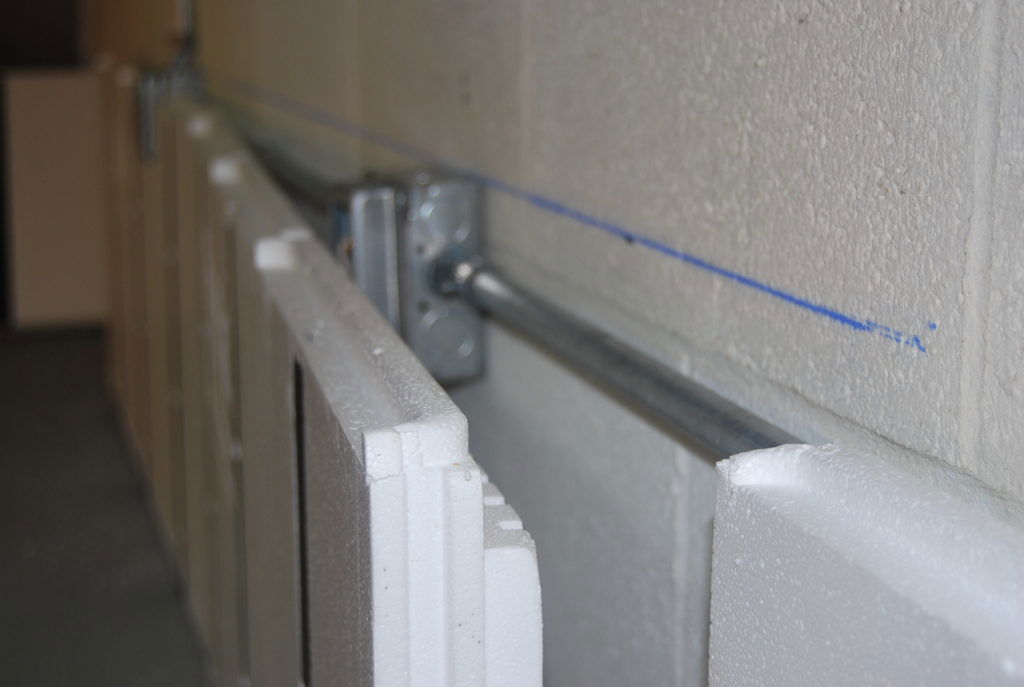
The blue chalk line is the top of the panel marked to indicate the height measured from the floor to adjust for the raceway’s location. We cut off 1 1/2″ from the bottom of the panel so to align the conduit to the raceway.
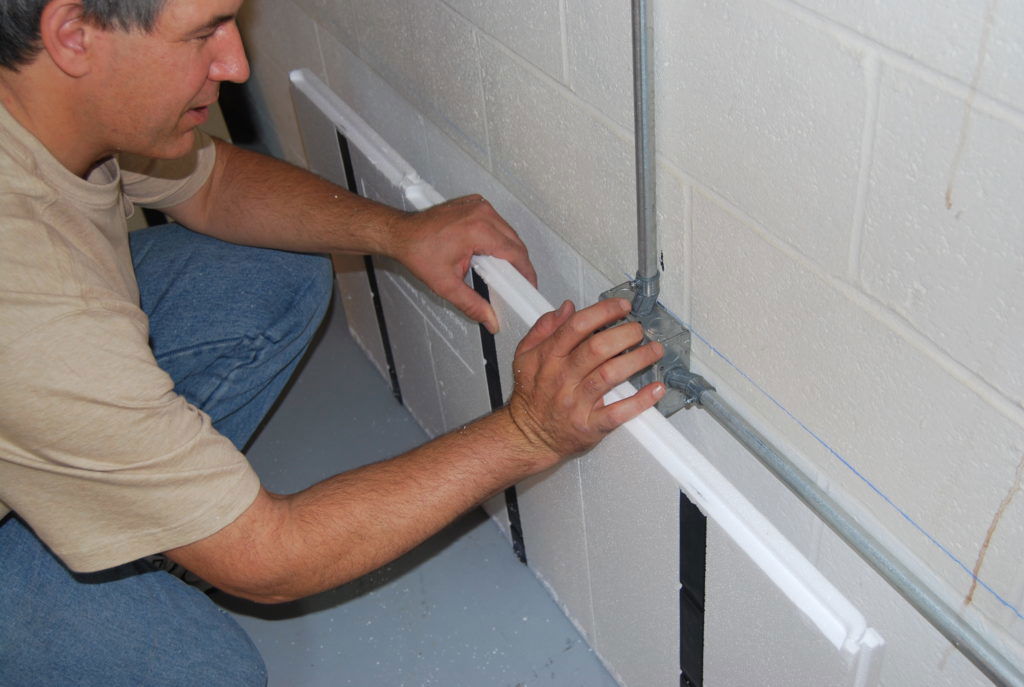
Ed presses the panel to the electrical box to indicate the foam needed to be removed from the panel.

Remove the foam with a razor knife or saw.

If you are planning on using rigid metal conduit, install the ½” metal conduit at the same height all the way around the project. Use box offsets so that the conduit is setting tight against the concrete wall.

4″Square Boxes: Use with lighting fixtures, switches, receptacles, and in other applications where multiple conductor runs are split into two or more directions.
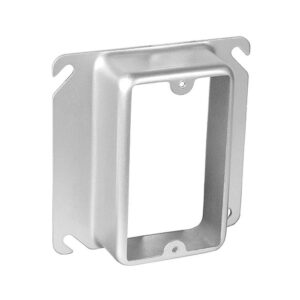
Square Metal Electrical Box Cover or mud ring.
You can cut the InSoFast panels as needed to align the horizontal chase way with the metal conduit. The cut off portion can be used at the top of the wall. This method utilizes the tongue and grooves to their best potential.
E3802.1 Installation and support requirements
InSoFast wiring methods shall be installed and supported in accordance with Table E3802.1.
INSTALLATION REQUIREMENTS
| Where run parallel with the framing member or furring strip, the wiring shall be not less than 11/4 inches from the edge of a furring strip or a framing member such as a joist, rafter or stud or shall be physically protected. (InSoFast panels raceways satisfy the required protection of 1¼”) |
| Bored holes in framing members for wiring shall be located not less than 11/4 inches from the edge of the framing member or shall be protected with a minimum 0.0625-inch steel plate or sleeve, a listed steel plate or other physical protection.( Raceways that are running through InSoFast studs do not require steel plates because they meet the 1 ¼” depth requirement) |
| Where installed in grooves, to be covered by wallboard, siding, paneling, carpeting, or similar finish, wiring methods shall be protected by 0.0625-inch-thick steel plate, sleeve, or equivalent, a listed steel plate or by not less than 11/4-inch free space for the full length of the groove in which the cable or raceway is installed.(InSoFast panels are engineered with a groove that forms a raceway with the required protection or “free space” of 1 ¼” along the full length of the groove) |
| Securely fastened bushings or grommets shall be provided to protect wiring run through openings in metal framing members. (InSoFast panels have no metal or sharp edges) |
| The maximum number of 90-degree bends shall not exceed four between junction boxes.(This does not apply to NM or Romex® wiring) |
| Bushings shall be provided where entering a box, fitting or enclosure unless the box or fitting is designed to afford equivalent protection. (does not apply to NM or Romex® wiring) |
| Ends of raceways shall be reamed to remove rough edges. (Raceways of InSoFast panels have no metal or sharp edges ) |
| Maximum allowable on center support spacing for the wiring method in feet. (The raceways of InSoFast panels provide continuous confinement and support for wiring) |
| Maximum support distance in inches from box or other terminations. (NM or Romex® wiring must be secured in place within 8” of boxes without cable clamps. Securing wiring with expanding foam adhesive (Great Stuff®) satisfies this requirement) |
Some projects may require the consultation of a certified electrician.


